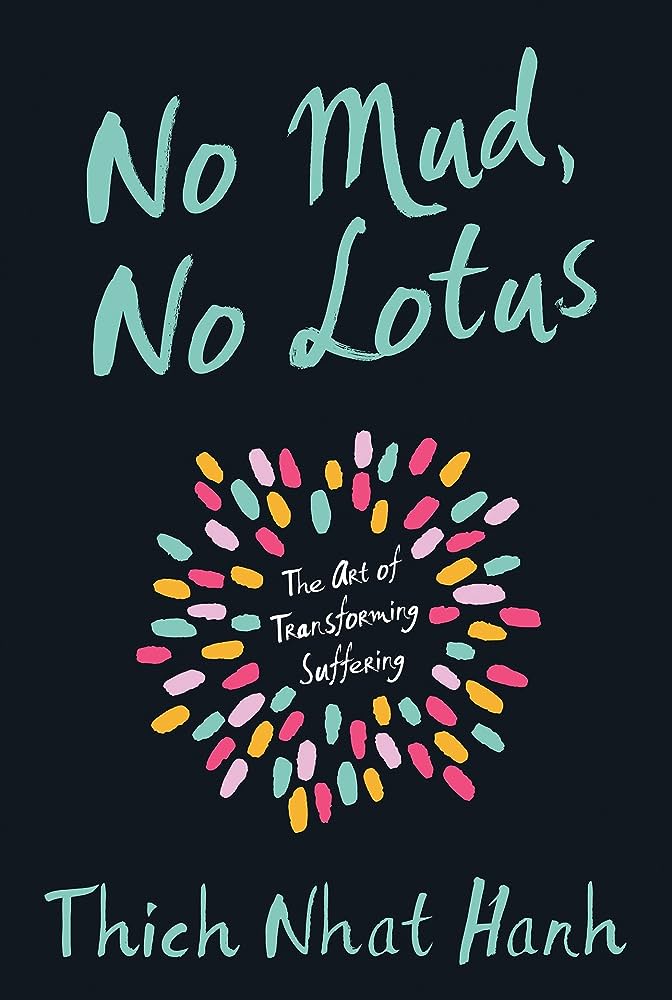“Most people are afraid of suffering. But suffering is a kind of mud to help the lotus flower of happiness grow.There can be no lotus flower without the mud.”—THICH NHAT HANH
In No Mud, No Lotus: The Art of Transforming Suffering, Vietnamese Thiền Buddhist monk Thich Nhat Hanh asserts that the art of happiness is also the art of suffering well. He offers practices and strategies for transforming suffering and finding true joy in life. Thich Nhat Hanh introduces the concept of non-duality: how to make good use of mud in order to produce beautiful lotus flowers, and how understanding our suffering gives birth to love and compassion.
The art of happiness is the art of suffering well.
Being able to enjoy happiness doesn’t require that we have zero suffering. In fact, the art of happiness is also the art of suffering well. When we learn to acknowledge, embrace, and understand our suffering, we suffer much less. Not only that, but we’re also able to go further and transform our suffering into understanding, compassion, and joy for ourselves and for others.
If we focus exclusively on pursuing happiness, we may regard suffering as something to be ignored or resisted. We think of it as something that gets in the way of happiness. But the art of happiness is also and at the same time the art of knowing how to suffer well. If we know how to use our suffering, we can transform it and suffer much less. Knowing how to suffer well is essential to realizing true happiness.
“If there’s no right, then there’s no left. Where there is no suffering, there can be no happiness either, and vice versa.”
No Mud, No Lotus
Everyone knows we need to have mud for lotuses to grow. The mud doesn’t smell so good, but the lotus flower smells very good. If you don’t have mud, the lotus won’t manifest. You can’t grow lotus flowers on marble. Without mud, there can be no lotus.
It is possible of course to get stuck in the “mud” of life. It’s easy enough to notice mud all over you at times. The hardest thing to practice is not allowing yourself to be overwhelmed by despair. When you’re overwhelmed by despair, all you can see is suffering everywhere you look. You feel as if the worst thing is happening to you. But we must remember that suffering is a kind of mud that we need in order to generate joy and happiness. Without suffering, there’s no happiness. So we shouldn’t discriminate against the mud. We have to learn how to embrace and cradle our own suffering and the suffering of the world, with a lot of tenderness.
THE FOUR NOBLE TRUTHS
The Buddha’s Four Noble Truths are: there is suffering; there is a course of action that generates suffering; suffering ceases (i.e., there is happiness); and there is a course of action leading to the cessation of suffering (the arising of happiness).
Mindfulness
Mindfulness is the best way to be with our suffering without being overwhelmed by it. Mindfulness is the capacity to dwell in the present moment, to know what’s happening in the here and now. To be mindful means to be aware. It’s the energy that knows what is happening in the present moment. With mindfulness, you can recognize the presence of the suffering in you and in the world. And it’s with that same energy that you tenderly embrace the suffering. By being aware of your in-breath and out-breath you generate the energy of mindfulness, so you can continue to cradle the suffering.
With mindfulness we are no longer afraid of pain. We can even go further and make good use of suffering to generate the energy of understanding and compassion that heals us and we can help others to heal and be happy as well.
All the best in your quest to get better. Don’t Settle: Live with Passion.



Comments are closed.